The Role of Spatial Location in Visual Working Memory

The ability to interact with the visual elements that surround us, considering that our relationship with the environment is inherently visual, depends largely on the mechanisms that temporarily retain and manipulate the relevant visual information as it appears and disappears around us. Studying the properties of visual working memory is relevant as this type of memory is involved in several tasks in which we engage daily in our everyday life and is associated with a variety of skills such as orientation, perception, imagination, classification of objects into different categories, and its identification and recognition.
A phenomenon that has received increased interest in the field of visual short-term memory research is the way our brain is able to not only represent simple object features such as color, shape, texture or size, but to properly combine and integrate them into a single coherent and unitary object. Neuroscience has proven that each of the visual features of objects are represented and processed separately and independently in the brain, but in an environment rich in visual elements, how does the brain unitize the different visual features to create integrated objects, preventing them to be incorrectly bound? The mechanism by which it is possible to integrate visual features is called binding and has attracted considerable attention in the context of visual short-term memory.
Researchers at the University of York, in collaboration with Dr. Judit Castellà, from the Department of Basic, Developmental and Educational Psychology at the UAB, have conducted a series of studies focused on exploring binding processes in visual memory. In the experiments, sets of colored shapes were presented that participants had to remember, followed by a single stimulus (visual suffix) that had to be ignored. These suffixes could be totally different to the to-be-remembered stimuli or either similar in shape, color or both, and the aim was to determine the interference effects caused by the suffix on the correct retention of the previously shown items. It was found that despite being irrelevant to the memory task, suffixes interfered with binding processes when they were similar or at least shared a visual feature with the stored objects. The findings were interpreted in terms of a feature-based filtering mechanism in visual working memory, with any stimuli that pass through this filter serving to directly overwrite existing representations of objects held in memory.
In a recent study, we investigated whether the spatial location of objects is automatically integrated with other features such as color, shape, etc. or whether they are separable elements. The same interference paradigm described above was used but in this case, in half of the trials, the visual suffixes overlaid the location of one of the to-be-remembered items. If the spatial location is automatically encoded, a worse recall performance should be expected in the overlaid condition. A series of experiments showed that the spatial location of the suffixes is registered in visual memory but the interference they cause depends solely on whether the position is a key element at retrieval. The results can be interpreted in terms of a separation between spatial information and other visual features, and also suggest that shape and color bindings may be retained and accessible independently of their location within the visual field, consistent with the idea of visual working memory as a set of abstract and flexible representations.
References
Allen, R. J.; Castellà, J.; Ueno, T.; Hitch, G. J.; Baddeley, A. D. What does visual suffix interference tell us about spatial location in working memory? Memory & Cognition. 2015, vol. 43, num. 1, p. 133-142. doi: 10.3758/s13421-014-0448-4.


